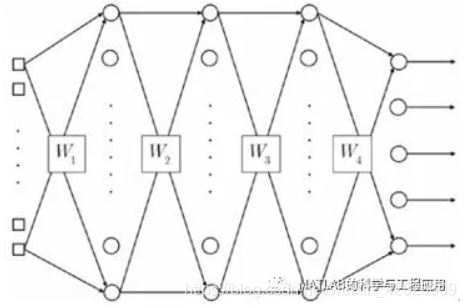【讀書1】【2017】MATLAB與深度學習——過度擬合(1)
該方法儘可能簡化神經網路的結構,從而減少過擬合的發生。(編注:正則化的簡化實質也是丟棄網路節點,不過正則化是按照某種規則丟棄,而dropout是隨機丟棄)
This method works as it simplifies theneural network’ architecture as much as possible, and hence reduces thepossible onset of overfitting.
第3章說明了這一點。
Chapter 3 explains this aspect.
此外,大量訓練資料的使用也非常有幫助,因為減少了由於特定資料引起的潛在偏差。
Furthermore, the use of massive trainingdata is also very helpful as the potential bias due to particular data isreduced.
計算量(Computational Load)
最後一個挑戰是完成訓練所需的時間。
The last challenge is the time required tocomplete the training.
權重的數量隨著隱藏層數量的增加而呈現幾何增長,因此需要更多的訓練資料。
The number of weights increasesgeometrically with the number of hidden layers, thus requiring more trainingdata.
最終就需要進行更多的計算。
This ultimately requires more calculationsto be made.
神經網路的計算量越大,訓練時間就越長。
The more computations the neural networkperforms, the longer the training takes.
這個問題在神經網路的實際發展中是非常嚴重的。
This problem is a serious concern in thepractical development of the neural network.
如果一個深度神經網路需要一個月來訓練,那麼每年只能修改20次。(?應該是12次吧)
If a deep neural network requires a monthto train, it can only be modified 20 times a year.
在這種情況下,一項有用的研究幾乎是不可能的。(太慢了!!!)
A useful research study is hardly possiblein this situation.
通過引入高效能硬體,如GPU和快速演算法(批處理歸一化),在很大程度上緩解了這一麻煩。
This trouble has been relieved to aconsiderable extent by the introduction of high-performance hardware, such asGPU, and algorithms, such as batch normalization.
本節介紹的小改進方法是使得深度學習成為機器學習英雄的驅動力。
The minor improvements that this sectionintroduced are the drivers that has made Deep Learning the hero of MachineLearning.
機器學習的三個主要研究領域通常為影象識別、語音識別和自然語言處理。
The three primary research areas of MachineLearning are usually said to be the image recognition, speech recognition, andnatural language processing.
這些領域都需要進行獨立的研究,以尋找合適的技術方法。
Each of these areas had been separatelystudied with specifically suitable techniques.
然而,目前深度學習優於這三個領域中使用的所有技術。
However, Deep Learning currentlyoutperforms all the techniques of all three areas.
示例:ReLU與dropout(Example: ReLU and Dropout)
本節實現了ReLU啟用函式和dropout這兩種代表性的深度學習技術。
This section implements the ReLU activationfunction and dropout, the representative techniques of Deep Learning.
這裡借用了第4章中數字分類的例子。
It reuses the example of the digitclassification from Chapter 4.
訓練資料仍然採用相同的5 x5方塊影象。
The training data is the same five-by-fivesquare images.

圖5-5 用5 x 5方塊影象訓練資料Training data in five-by-five square images
考慮具有三個隱藏層的深度神經網路,如圖5-6所示。
Consider the deep neural network with thethree hidden layers, as shown in Figure 5-6.

圖5-6 三隱層的深度神經網路The deep neural networkwith three hidden layers
每個隱藏層包含20個節點。
Each hidden layer contains 20 nodes.
網路有25個輸入節點用於矩陣輸入,五個輸出節點對應五個類別。
The network has 25 input nodes for thematrix input and five output nodes for the five classes.
輸出節點採用softmax啟用函式。
The output nodes employ the softmaxactivation function.
——本文譯自Phil Kim所著的《Matlab Deep Learning》
更多精彩文章請關注微訊號:
